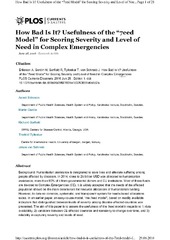| dc.contributor.author | Eriksson, Anneli | en_US |
| dc.contributor.author | Gerdin, Martin | en_US |
| dc.contributor.author | Garfield, Richard | en_US |
| dc.contributor.author | Tylleskär, Thorkild | en_US |
| dc.contributor.author | von Schreeb, Johan | en_US |
| dc.date.accessioned | 2016-09-02T09:44:03Z | |
| dc.date.available | 2016-09-02T09:44:03Z | |
| dc.date.issued | 2016 | |
| dc.Published | PLOS Currents 2016, Edition 1 | eng |
| dc.identifier.issn | 2157-3999 | |
| dc.identifier.uri | https://hdl.handle.net/1956/12716 | |
| dc.description.abstract | Background: Humanitarian assistance is designated to save lives and alleviate suffering among people affected by disasters. In 2014, close to 25 billion USD was allocated to humanitarian assistance, more than 80% of it from governmental donors and EU institutions. Most of these funds are devoted to Complex Emergencies (CE). It is widely accepted that the needs of the affected population should be the main determinant for resource allocations of humanitarian funding. However, to date no common, systematic, and transparent system for needs-based allocations exists. In an earlier paper, an easy-to-use model, “the 7eed model”, based on readily available indicators that distinguished between levels of severity among disaster-affected countries was presented. The aim of this paper is to assess the usefulness of the 7eed model in regards to 1) data availability, 2) variations between CE effected countries and sensitivity to change over time, and 3) reliability in capturing severity and levels of need. Method: We applied the 7eed model to 25 countries with CE using data from 2013 to 2015. Data availability and indicator value variations were assessed using heat maps. To calculate a severity score and a needs score, we applied a standardised mathematical formula, based on the UTSTEIN template. We assessed the model for reliability on previous CEs with a “known” outcome in terms of excess mortality. Results: Most of the required data was available for nearly all countries and indicators, and availability increased over time. The 7eed model was able to discriminate between levels of severity and needs among countries. Comparison with historical complex disasters showed a correlation between excess mortality and severity score. Conclusion: Our study indicates that the proposed 7eed model can serve as a useful tool for setting funding levels for humanitarian assistance according to measurable levels of need. The 7eed model provides national level information but does not take into account local variations or specific contextual factors. | en_US |
| dc.language.iso | eng | eng |
| dc.relation.uri | http://currents.plos.org/disasters/ | |
| dc.rights | Attribution CC BY | eng |
| dc.rights.uri | http://creativecommons.org/licenses/by/4.0 | eng |
| dc.title | How bad is it? Usefulness of the “7eed Model” for scoring severity and level of need in complex emergencies | en_US |
| dc.type | Peer reviewed | |
| dc.type | Journal article | |
| dc.date.updated | 2016-08-29T14:45:54Z | |
| dc.description.version | publishedVersion | en_US |
| dc.rights.holder | Copyright 2016 The Authors | |
| dc.identifier.doi | https://doi.org/10.1371/currents.dis.d59e0fa39887031e1c3763851a6e5c2a | |
| dc.identifier.cristin | 1376422 | |

